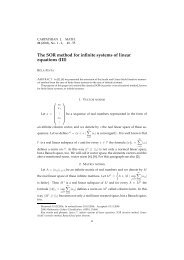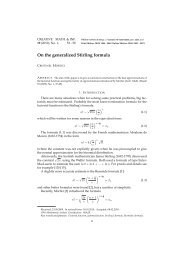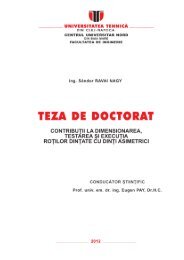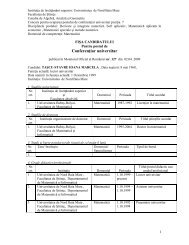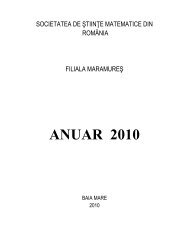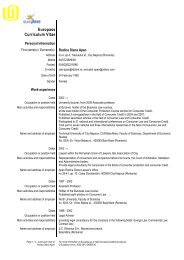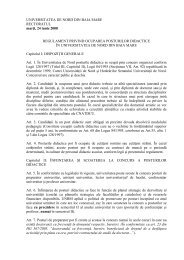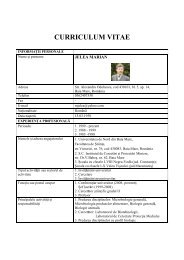Vol 3 (1) 2011 - UBM :: Departamentul de Chimie-Biologie
Vol 3 (1) 2011 - UBM :: Departamentul de Chimie-Biologie
Vol 3 (1) 2011 - UBM :: Departamentul de Chimie-Biologie
Create successful ePaper yourself
Turn your PDF publications into a flip-book with our unique Google optimized e-Paper software.
R.V. Kale, S.S. Kadam, Syed Imran Hashmi, Studies on effect of different varieties of date palm paste<br />
incorporation on quality characteristics of yoghurt<br />
2.2.2. Preparation of date paste<br />
Ripe fruit with firm texture, uniform<br />
in size and maturity were used for the<br />
experiment. After cleaning the fruits,<br />
preliminary trials were conducted to<br />
standardize the methods of preparation of<br />
paste for this purpose. The optimum quality<br />
fruits of two different varieties were selected<br />
and manual separation of seed was carried<br />
out. Further, the fruit was cut into small<br />
pieces and grin<strong>de</strong>r to obtained paste.<br />
2.2.3. Preparation of yoghurt<br />
Preparation of starter culture (mother<br />
culture)<br />
The culture which was obtained from<br />
Subculturing i.e. Streptococcus<br />
thermophillus and Lactobacillus <strong>de</strong>lbrueckii<br />
subsp.Bulgaricus was inoculated in conical<br />
flask containing sterilized 50ml cow milk in<br />
laminar flow. Then the milk was incubated<br />
at 42-45 0 C till the firm coagulum was<br />
formed.<br />
Preparation of batch culture<br />
Batch culture was prepared by<br />
inoculating 3 per cent of mother culture into<br />
200 ml of sterilized cow milk and incubated<br />
at 42-45 0 C till firm coagulum was formed.<br />
The bulk culture was stored in refrigeration.<br />
Raw Materials<br />
The main raw material of yoghurt is<br />
fresh cow’s milk. The milk contains about<br />
13% TSS, including 3.5% fat. Skim milk<br />
pow<strong>de</strong>r (SMP) was used for fortification of<br />
the liquid milk.<br />
Standardization/Mixing<br />
Medium-fat yoghurt was produced,<br />
containing 1.5% milk fat. Centrifugal<br />
separation is used to remove about 2% of fat<br />
from the initial liquid milk and clarify the<br />
raw milk. The milk was fortified with milk<br />
proteins to produce a thick-body yoghurt<br />
product. Nonfat dry milk (NFDM) at the rate<br />
of 4% is usually ad<strong>de</strong>d. Milk protein<br />
stabilizers, used to prevent whey separation<br />
(syneresis) of yoghurt, are ad<strong>de</strong>d at the rate<br />
of about 0.3%.<br />
Homogenization<br />
The mixture of milk ingredients was<br />
homogenized in a high-pressure continuous<br />
homogenizer, operated at about 200 kg/cm 2<br />
pressure and temperature of 55 0 C.<br />
Homogenization retards fat separation<br />
(creaming) and improves the water-binding<br />
properties of milk proteins (casein).<br />
Heat Treatment<br />
The homogenized milk was heated to<br />
about 90 0 C for 5 min for increasing the<br />
water-binding capacity of milk proteins and<br />
<strong>de</strong>naturation of the whey proteins. At the<br />
same time the milk mixture is pasteurized,<br />
i.e. all pathogenic and most spoilage bacteria<br />
are inactivated.<br />
Fermentation<br />
The heated milk mixture is cooled to<br />
about 45 0 C and it is inoculated with a<br />
yoghurt culture. The yoghurt inoculums (wet<br />
a mixed culture of Lactobacillus bulgaricus<br />
and Streptococcus thermophilus in<br />
proportion of 3% of the milk mixture was<br />
incubated at 45 o C, after which a firm<br />
coagulum was formed. Set yoghurt was<br />
prepared by packaging the inoculated milk<br />
mixture into consumer cups and incubating<br />
the aseptically sealed packages at 45 o C for<br />
3–4 hr.<br />
Mixing of Yoghurt<br />
The bulk-set yoghurt is cooled to<br />
15 o C, the yoghurt containing date paste was<br />
prepared by gentle mixing of bulk yoghurt<br />
with about 10%, 15% and 20% of date palm<br />
fruit paste. The fruit product, containing<br />
yoghurt was stored at refrigeration<br />
temperature.<br />
32



